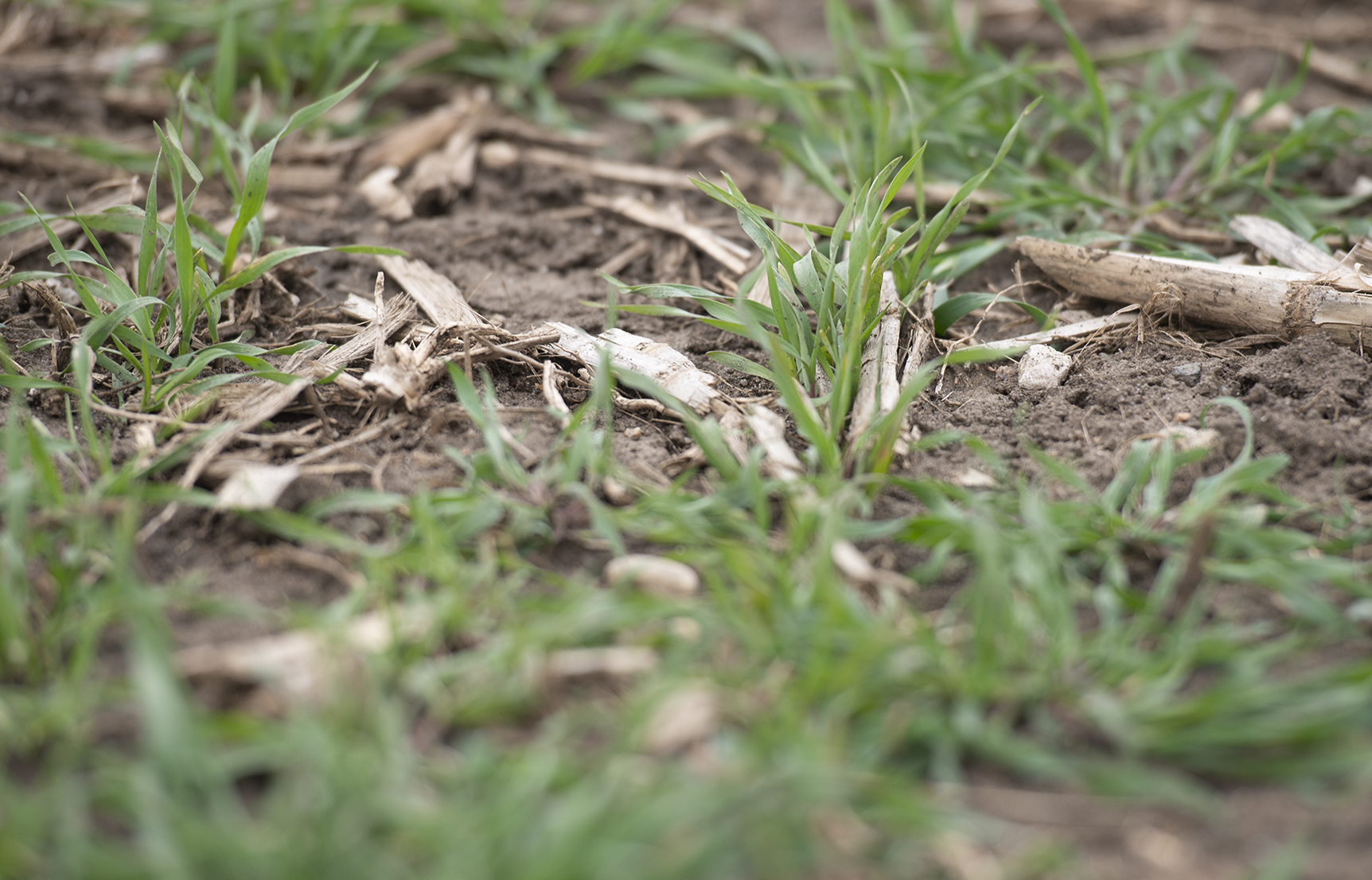
Farmers use cover crops on their fields as a way to sequester nutrients. According to a INREC survey, farmers planted more than 2 million acres to cover crops in 2019. (Photo: Iowa Soybean Association)
2020 record year for conservation adoption
April 22, 2021 | Bethany Baratta
In Iowa, 2020 was a banner year for conservation adoption. Iowa Secretary of Agriculture Mike Naig shed light on farmers’ work to expand their conservation efforts during a recent webinar hosted by Iowa Learning Farms.
The state invested $6.5 million in 2020 through cost-share programs. Private landowners matched that investment in building terraces, water and sediment control basins, grade stabilization projects and through the implementation of cover crops and grassed waterways.
“2020 was a record year when it comes to conservation adoption in the state,” Naig says. “Never have we had more funding, focus, partners and awareness of what needed to be done across the state.”
Naig says scaling up efforts through Water Quality Initiatives (WQI) boosted conservation adoption in Iowa.
“It’s taken 15 years to build 100 wetlands and in one year we’ve got 44 in development,” Naig says. The results are reflective of funding available through Senate File 512 as well as the collaboration and cooperation from farmers, local and state governments and other partners, he said.
There were 45 saturated buffers and bioreactors under development in 2020. The Iowa Department of Agriculture and Land Stewardship (IDALS) enrolled 3,500 farmers and landowners in the state’s Water Quality Initiative in 2020. Those farmers and landowners planted 585,000 acres of cover crops in 2020, but that doesn’t account for cover crops planted using other funding sources or private investments.
Iowa Soybean Association (ISA) President Jeff Jorgenson hopes the momentum for the adoption of conservation practices grow in 2021.
“We hope IDALS hits a new record yet this year in what they’re able to help initiate for conservation practices,” Jorgenson says.
He’s boosted conservation efforts on his farm, especially cover crops.
Grazing 110 cows on cover crops is working well because it lowers feed costs while also helping to sequester nutrients.
“The biggest thing is nutrient management,” Jorgenson says. “We farm a lot of river bottom ground and a fair amount of highly erodible ground. We want to make sure nutrients stay in place for the crop we’re going to grow.”
Iowa farmers grew 2.18 million acres of cover crops in 2019, according to the most recent Iowa Nutrient Research & Education Council (INREC) survey.
Each conservation project helps the state move closer to its goals outlined in the Iowa Nutrient Reduction Strategy. While 2020 was a banner year, the Iowa Secretary of Agriculture says the department isn’t resting.
“Whatever we accomplished we can be proud of, but never satisfied,” Naig says. “We want to accomplish twice as much in half the time. How do we reach farther and get better at doing what we’re doing?”
Farm-focused approach
In pursuit of meeting the needs of the Iowa Nutrient Reduction Strategy, the ISA Research Center for Farming Innovation (RCFI) offers leadership, scientific, and technical services to farmers, watershed groups and conservation partners. The primary strategy seeks to advance science-based and data-driven programming resulting in improvements for natural resources and environmental quality, while also leading to more productive, efficient and profitable soybean production. This work is primarily driven by engaging and empowering farmers directly in locally relevant geographic initiative projects as well as projects at farm field and edge-of-field scales.
“There’s great alignment between the Iowa Nutrient Reduction Strategy and the work we do here at the Research Center for Farming Innovation because the big common denominator is farmers want to know how to fit these practices into their operations. They want to know what works on their farm. Our research helps inform those decisions,” says Roger Wolf, director of ISA’s RCFI.
Historically, ISA RCFI has coordinated efforts with upwards of 80 plus partners. ISA Research leverages soybean checkoff funding with numerous other non-checkoff projects with support via public and private grants and contracts.
Projects have included complete watershed characterization and planning, nutrient management planning, conservation finance, agronomic field trials/testing, technical assistance, and implementation and performance monitoring of in-field and edge-of-field practices including oxbow restorations, bioreactors, saturated buffers and cover crops. ISA’s water lab provides additional services to help characterize stream, lake and groundwater quality and documents the relative effectiveness of implemented conservation practices. The laboratory is certified for nitrate/nitrite, fluoride, and coliform analysis by the State of Iowa.
ISA Research highlights for the 2019-2020 Iowa Nutrient Reduction Strategy reporting period include:
- More than 35 projects addressing soil conservation, water quality, and other nutrient reduction strategy efforts
- $2,284,884 in dedicated funding toward soil conservation, water quality, and nutrient reduction
- More than 3,300 water samples collected and analyzed
- 60 plus media pieces showcasing nutrient reduction strategy efforts
- Numerous fields days, tours, watershed events, and conferences
While the goal of the plan is nutrient reduction, Wolf says he’s excited about the opportunities for farmers.
“Conservation shouldn’t be a build on, add on, it should be embedded in the business of farming,” Wolf says. “I think we’re driven to do that. We’re going to have stronger soils and cleaner water, more and diverse crops. More productive crops. More valuable crops. That’s the future.”
Watch this video to learn more about the efforts in the state.
Back